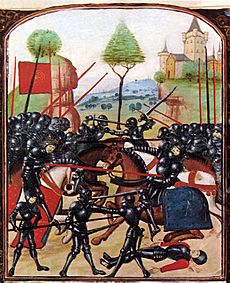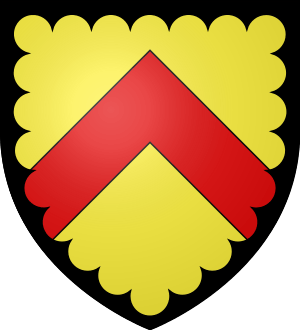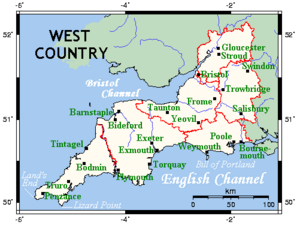Humphrey Stafford, 1st Earl of Devon facts for kids
Sir Humphrey Stafford, 1st Earl of Devon, 1st Baron Stafford of Southwick (born around 1439 – died 17 August 1469) was a very powerful noble in South West England during the mid-1400s. He was also involved in the Wars of the Roses, a series of wars fought over who should be king of England.
Humphrey Stafford was distantly related to the Earls of Stafford. He became the biggest landowner in Dorset county because of family inheritances. Later, King Edward IV quickly promoted Stafford and other men. This was to fill the empty spots left by nobles who had died or lost their lands because they supported the losing side (the Lancastrians). In the West Country, Stafford especially benefited from the lands taken from the Courtenay family, who were Lancastrian supporters. In 1469, he was given the Courtenay family's important title of Earl of Devon.
Stafford held the title of Earl for only three months. In July 1469, he was sent north to stop a rebellion. This uprising was started by the unhappy Earl of Warwick. Even though Stafford escaped the terrible Battle of Edgcote, a group of angry people attacked and killed him in Bridgwater on 17 August 1469. Many people thought Stafford was too ambitious. However, he was also a skilled leader and manager, and the king trusted him completely.
Sir Humphrey Stafford's Family
The Stafford family from Hooke in Dorset and Southwick in Wiltshire was a younger branch of the main Stafford family. This main family included the Earls of Stafford and later the Dukes of Buckingham.
Humphrey Stafford's grandfather was Sir Humphrey Stafford (died 1442), who was known as "of the silver hand." His grandson, another Humphrey Stafford, inherited his lands but died in 1461 without having children. This meant that Humphrey Stafford, who would become the Earl of Devon, inherited all the family lands. Most of these lands were in Dorset, with others in Somerset and Wiltshire.
Humphrey's father, William Stafford (died 1450), had already passed away. He was killed during Jack Cade's Rebellion on 18 June 1450. Humphrey's great-uncle was John Stafford, who was the Archbishop of Canterbury from 1443 to 1452.
Inheriting these family lands made Humphrey Stafford the biggest landowner in Dorset. Through his mother, Katherine, he also inherited property from her father, John Chidiock, who was another important landowner in the southwest. Humphrey married Isabel, the daughter of Sir John Barre from Herefordshire, sometime after June 1450.
Working for King Edward IV
In the late 1450s, Stafford might have worked for his distant relative, John Stafford, Earl of Wiltshire. This Earl was the son of Humphrey Stafford, Duke of Buckingham. Stafford's connection with James Touchet, Baron Audley, who was one of Wiltshire's men, suggests this. If so, it was a brief time when he supported the House of Lancaster in the civil war against the House of York.
In 1460, Stafford and Audley were sent to Guînes to help the English soldiers there. Bad weather forced their ships into the port of Calais. Calais was controlled by the Yorkist leader Richard Neville, Earl of Warwick. While there, both Stafford and Audley were convinced to join the Yorkist side.
Stafford fought in the Battle of Mortimer's Cross on 2 February 1461. In this battle, the Yorkist army, led by Edward, Earl of March, won a big victory. After the Battle of Towton on 29 March that same year, Stafford was made a knight by Edward. Edward had just been declared King Edward IV, after King Henry VI was removed from power.
Later that year, on 26 July, Stafford was called to Parliament for the first time. He was given the title Lord Stafford of Southwick. Over the next few years, the king gave him many lands and important jobs. In 1461, he became the manager of the Duchy of Cornwall and the leader of Bristol Castle. In 1462, he received most of the lands in Devon that belonged to Thomas Courtenay, Earl of Devon. Courtenay had been captured at Towton and executed. In 1464, Stafford was made the keeper of Dartmoor. In 1467, he was given even more of the Courtenay family's lands.
Stafford showed his loyalty to the king by serving him well in his home region. This area had strongly supported the Lancastrian side before. Throughout the 1460s, Stafford led local court meetings and other legal groups across the West Country. His work was not just about law. In 1461–1462, he served in the army against the Scots. In 1468, he helped with talks between England and Brittany. In 1469, he joined the king's special group of advisors, the Royal Council. He also served on the group that found Henry Courtenay, Thomas Courtenay's brother, guilty of treason (betraying the king).
Some people, like the writer John Warkworth, believed Henry's downfall was due to Stafford's clever plans. Stafford was rewarded with more land and made Earl of Devon on 17 May 1469. However, King Edward himself was very interested in Courtenay's trial. It is more likely that the decision was made because Edward needed a loyal person to control that region.
His Final Days
Stafford's quick rise to power was noticed by other powerful nobles. In 1468, the unhappy Warwick said that the Earl of Devon had too much influence over King Edward. Warwick and Devon later made up, but the next year Warwick made the same accusations again.
Warwick started a rebellion in Yorkshire, led by someone called "Robin of Redesdale." At the same time, Warwick and George, Duke of Clarence, King Edward's brother, invaded England from Warwick's strong base in Calais. Devon and William Herbert, Earl of Pembroke, were ordered to gather soldiers to stop the rebellion.

The king's army, led by Devon and Pembroke, met the northern rebels near Banbury in Oxfordshire. The rebels were on their way south to meet Warwick and Clarence. What happened next is not completely clear.
According to Warkworth, Devon and Pembroke argued about where to house their soldiers. Devon then left with most of the archers (bowmen). The next day, 24 July 1469, Pembroke fought the rebels at the Battle of Edgcote. Without Devon's archers, Pembroke's army was completely defeated. Pembroke was captured and executed by Warwick's order.
However, another writer, Jean de Waurin, tells a different story. According to Waurin, Devon left the battlefield when he heard that Clarence was arriving with more soldiers. In any case, Devon managed to escape the battle. But he was later captured by an angry crowd in Bridgwater in Somerset. He was executed on 17 August.
Stafford had been Earl of Devon for exactly three months when he died. He and Isabel did not have any children. So, when he died, his title ended. It was given back the next year to John Courtenay, who was the brother of Thomas, the last Courtenay earl of Devon. Stafford was buried in Glastonbury Abbey. After his death, his cousins argued over who should get his lands.
Many people at the time thought Stafford was too ambitious and not always honest. This is shown by Warkworth saying he was involved in Henry Courtenay's downfall. Warwick also called him one of King Edward's bad advisors. Modern historians, like Charles Ross, have also described him as "greedy and ambitious."
However, no one could doubt his skills as a leader and manager. King Edward relied on him heavily. Stafford could also show a kinder side. Historian Michael Hicks notes that from 1467 onwards, Stafford added special notes to his will. He did this "to right the wrongs that he was conscious of committing." He added the last of these notes just before his own execution.
Images for kids




